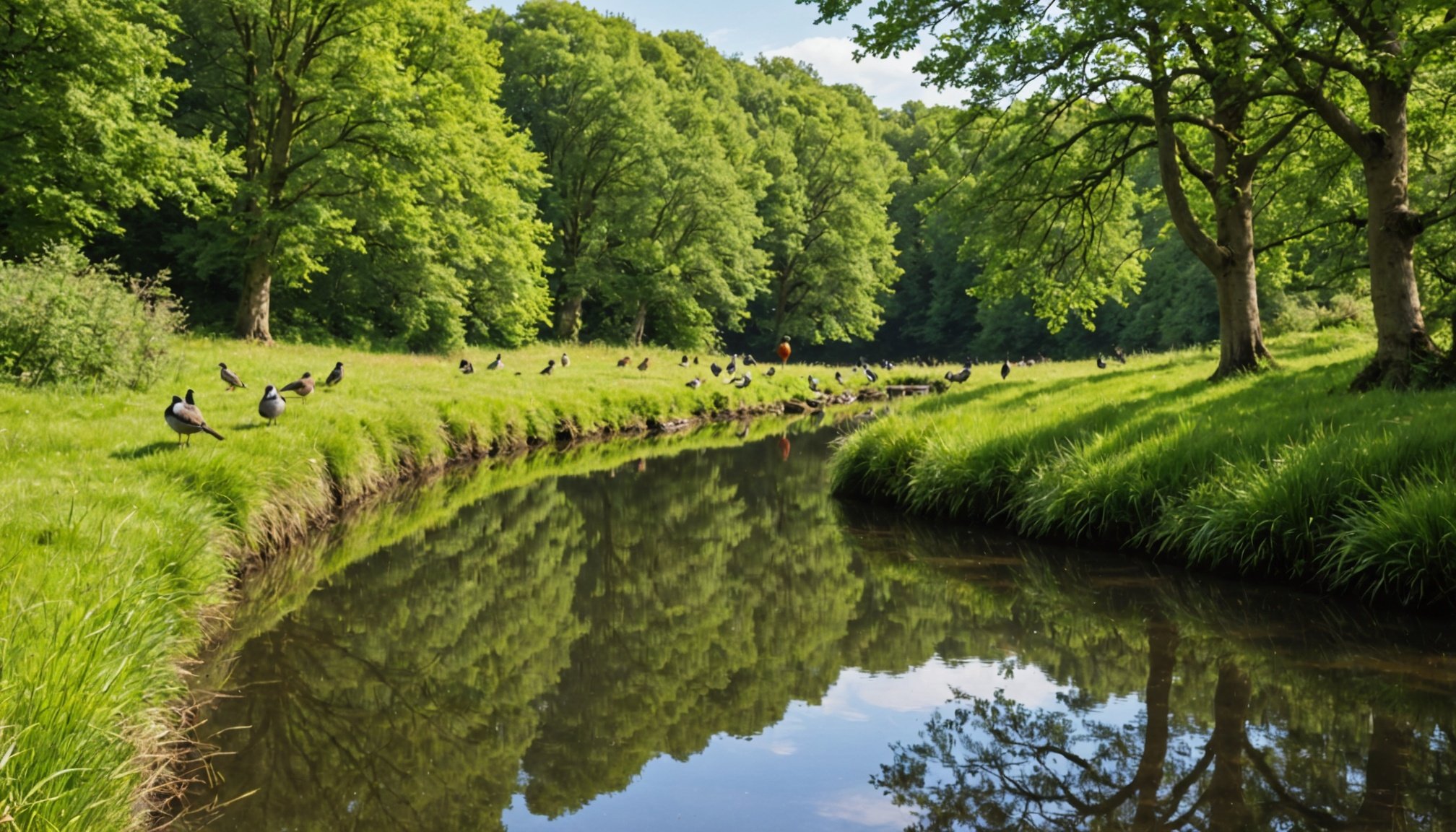Overview of Birdwatching in the UK
The UK stands as a formidable destination for birdwatching enthusiasts. Renowned globally, the rich variety of bird species accentuates its status. With diverse habitats ranging from rugged coastlines to sprawling woodlands, the UK offers myriad birdwatching opportunities in every season.
Birdwatching Locations are abundant and offer varied experiences. The UK is home to around 600 species. Common bird species like robins, sparrows, and more exotic arrivals create a vibrant avian tapestry. Those embarking on birdwatching in the UK will find that each location offers distinct avian residents, influenced by factors such as season, habitat, and migration patterns.
Also read : Top UK Campsites Perfect for Exciting Scuba Diving Experiences!
Seasonal variations are a critical aspect of birdwatching in the UK. Each season unfolds unique chances to observe different bird species. Spring is synonymous with migratory arrivals, while autumn showcases the departures of these same species. Winter, albeit colder, offers the sight of native species prominently. Hence, timing a visit is integral to a fruitful experience.
By incorporating the right mix of knowledge and timing, birdwatchers of all skill levels can revel in the UK’s bountiful birdwatching landscape. With each region offering its unique charm, the adventure promises enriching encounters with countless feathered friends.
In the same genre : Uncover Historic UK Campsites with Captivating Tours and Enlightening Talks
Top UK Campsites for Birdwatching
Embarking on a birdwatching adventure in the UK can be greatly enhanced by selecting the right campsites for birdwatching. The ideal locations provide proximity to rich avian habitats and offer comfortable amenities for nature enthusiasts. When choosing a site, consider factors such as diversity of local bird species, accessibility, and user feedback.
Best Campsites Across Various UK Regions
-
Dorset: Renowned for its beautiful landscapes, Dorset is home to some of the best campsites for birdwatching. The Isle of Purbeck, in particular, is favoured for its rich coastal and heathland bird species.
-
Norfolk: This region boasts numerous birdwatching campsites. The Norfolk Broads offer unique landscapes ideal for observing wetland birdlife.
-
Yorkshire Dales: Known for its picturesque views and diverse birdlife, this area provides excellent access to woodland and moorland species.
User ratings often highlight the balance between nature access and campsite facilities. Accessibility considerations, such as transport links and facilities for people with disabilities, are crucial. Prioritising campsites with positive user reviews ensures a rewarding and enjoyable experience in the world of birdwatching.
Bird Species to Look Out For
Venturing into birdwatching in the UK unveils an exciting opportunity to discover a wide array of UK bird species. This birdwatching guide aims to lead enthusiasts through the vastness of avian life, encapsulating environments from coastal edges to urban expanses.
Coastal Bird Species
The UK’s coastal areas are home to remarkable species such as puffins and gannets. The diversity in these habitats makes them prime locations for observing sea birds, offering distinct experiences. Coastal bird species often congregate in regions like Cornwall and East Anglia. Campsites for birdwatching near such areas provide advantageous positions to witness these birds in their natural settings.
Woodland Bird Species
Woodlands host charismatic bird species including woodpeckers and nuthatches. These birds thrive amidst trees and dense foliage, requiring a quieter approach to observation. Tents nestled near UK woodlands allow campers to wake up to melodious birdsong and observe birds during their most active periods. Opting for campsites with trails increases the chance of successful sightings.
Urban Bird Species
Even cities bustle with avifauna interest, offering surprising birdwatching opportunities. Sparrows, pigeons, and even the occasional peregrine falcon can be spotted. Urban birdwatching guides often include parks and green spaces within city limits, making it convenient for nature watchers to indulge in their hobby without venturing far from urban amenities.
Birdwatching Techniques and Tips
For enthusiasts eager to delve into effective birdwatching techniques, mastering essential skills can elevate the experience. An adept birdwatcher must employ techniques such as stealth and patience. These are crucial when approaching habitats without disturbing the avian life.
Binoculars play a vital role in enhancing visibility. Selecting the right pair involves considering magnification power and lens diameter, which affect clarity and field of view. Spotting scopes cater to distant sightings, crucial for exploring expansive landscapes like coastal areas or open moors.
When considering birdwatching gear, beginners should focus on portable options. A lightweight field guide aids in quick identification of bird species. Meanwhile, seasoned experts might utilise more advanced gadgets, like audio recorders, to capture bird calls for later analysis.
Concealment clothing is another investment promoting non-intrusive observation. Remaining still and blending with natural surroundings increases the chance of encountering elusive bird species, especially in woodland habitats.
Remember, practice refines technique, so frequent experiences in the field amplify skills over time. Exploring different terrains enhances adaptability, a hallmark of proficient birdwatchers. Whether a novice or a seasoned aficionado, embracing continual learning fosters a rewarding birdwatching journey.
Seasonal Birdwatching Guides
For enthusiasts exploring Seasonal Birdwatching UK, understanding time-specific opportunities is crucial. Different times of the year bring unique birdwatching experiences as migration patterns and local bird behaviour change. Birdwatching Calendar tools can help pinpoint the best periods.
Best Times for Birdwatching
The UK birdwatching seasons are defined by changes in bird presence and behaviour. During spring, the UK welcomes numerous migratory species returning to breed, creating an exciting atmosphere for birdwatchers. The abundance of songbirds adds a melodious backdrop.
Summer brings the chance to observe a wide range of bird species thriving in their breeding habitats. Birds are more active and visible, with young fledglings often sighted.
In autumn, many species embark on their migratory journeys, offering spectacular views of large avian flocks. It’s a dynamic time to witness these natural movements.
Winter provides opportunities to sight more elusive native species and certain migrants escaping the harsher climates of Northern Europe. The subdued landscape highlights the vibrant presence of cold-weather specialists.
By consulting a well-informed Birdwatching Calendar, birdwatchers can strategically plan trips aligned with seasonal highlights, ensuring an enriching experience throughout the year.
Maps and Resources for Birdwatchers
Delving into birdwatching maps enhances the experience, guiding enthusiasts to prime locations while increasing their understanding of topography. Such maps spotlight rich habitats, facilitating encounters with diverse UK bird species.
Utilising birdwatching resources is invaluable for both novice and experienced birdwatchers. These include online platforms and apps that provide real-time sighting information and identification tools. Popular resources feature detailed guides to regional birdwatching locations, assisting with the identification of common birds across the UK.
Accessing local birdwatching guides plays a pivotal role in effective exploration. Numerous guidebooks offer insights into specific areas within the UK, including seasonal advice on when and where to spot certain species. These can be found in bookstores or specialised birdwatching centres.
For those preferring digital options, apps dedicated to birdwatching provide interactive maps and comprehensive data on bird species. Engaging with such resources not only enriches the birdwatching journey but also enhances knowledge about avian habits and habitats.
Incorporating maps and resources efficiently transforms a simple outing into an informative adventure, allowing birdwatchers to navigate environments skillfully and make the most of their avian encounters.
User Reviews and Experiences
When diving into birdwatching experiences, user feedback can be a valuable resource. Camping reviews often reveal insights that go beyond the promotional material of campsites, offering practical advice based on real experiences. Such reviews typically cover elements like the diversity of bird species, the maintenance of facilities, and the overall quality of the birdwatching locations.
Travellers share various levels of satisfaction in their birdwatching experiences, with some praising campsites for strategic placement near access points to rich habitats, while others might highlight issues like noise or accessibility challenges. Reading through multiple reviews can help potential birdwatchers identify consistent patterns, either favourable or otherwise, that could influence their decisions.
Participating in online communities is another approach. These platforms make it easy to gather user feedback and make connections with other enthusiasts. Websites and forums often host discussions about the best times for birdwatching, gear recommendations, and even birdwatching maps specific to the UK regions. This collaborative knowledge sharing ensures a more tailored and engaging birdwatching journey.
Ultimately, by taking into account a variety of user reviews and leveraging collective experiences, birdwatchers can refine their choices and enhance their adventures.











